Commercial Salmon Fisheries
Southeast Alaska & Yakutat Research: Situk River Chinook and Sockeye Salmon Research

Figure 1. — Click for more Info

Figure 2. — Click for more Info
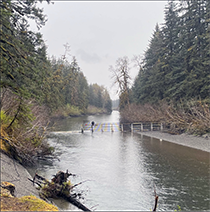
Figure 3. — Click for more Info
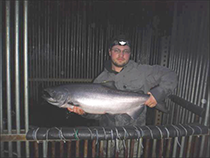
Figure 4. — Click for more Info
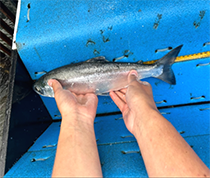
Figure 5. — Click for more Info
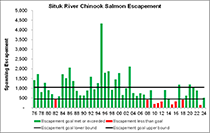
Figure 6. — Click for more Info
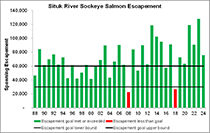
Figure 7. — Click for more Info
Overview
The Situk River is a small river located approximately 15 km southeast of Yakutat, Alaska (Figure 1). The river is approximately 35 km (22 miles) in length and flows out of Mountain and Situk Lakes. The Situk, Ahrnklin, and Lost Rivers flow into the Situk-Ahrnklin Inlet that empties into the Gulf of Alaska. The Situk River supports the largest run of steelhead trout in Alaska, a moderate run of Chinook salmon, very large runs of sockeye, pink, and coho salmon, and a few chum salmon. Yakutat is accessed by major airlines, and the Situk River is accessed from Yakutat by the Lost River Road in the lower river, and about 20 km further upriver by Forest Highway 10. Large runs of steelhead trout and sockeye and coho salmon, coupled with relatively easy access by Alaskan standards, are prime reasons why the Situk River is world renowned and a virtual paradise for recreational fishers. In addition, Situk River salmon support the oldest and most lucrative commercial set gillnet fishery in the Yakutat Management Area (Hoffman 2022a) accounting for around half of the commercial salmon harvest in the Yakutat area and averaging over $1.2 million in ex-vessel value between 2011–2020 (Hoffman 2022b). Situk River salmon also supports the most important subsistence fishery in the area with typical annual harvests of around 2,700 sockeye salmon, as example.
The Alaska Department of Fish and Game (ADF&G) actively manages sport, commercial, and subsistence fisheries in the to achieve the escapement goal ranges of 450–1,050 large (essentially 28" and greater in length) Chinook salmon (McPherson et al. 2005), (Figure 2) and 30,000–70,000 sockeye salmon (Clark et al. 1995, 2002), annually. Inseason management of Situk River Chinook and sockeye salmon is based on weekly harvest summaries from the commercial set gillnet fishery operating in the Situk-Ahrnklin Inlet, any available sport and subsistence summaries, and daily weir counts.
Each year a weir is installed across the Situk River about 2 km upstream from the Situk-Ahrnklin Inlet (Figures 1–3). Historically this weir was located about 20 km above the inlet and just downstream of the Nine Mile Bridge on Forest Highway 10. However, in the effort to gather run information in a timelier manner and to better assist with inseason management, the weir was moved to the lower river in 1988. The weir is installed in the same stretch of the river each year and is usually "fish tight" by early May and remains operational through early August.
From early May to mid-June the weir is operated by the Division of Sport fish personal to count the outmigration of steelhead trout and sample a representative percentage of the run for age (pulling scales), sex, and length information. From mid-June to mid-August the weir is operated by the Division of Commercial Fisheries to enumerate all five species of salmon that pass through the weir and to also sample a representative percentage of both Chinook and sockeye salmon for age (pulling scales), sex and length information (Figure 4 and 5). This information is used to compare years and look for any trends.
Annual spawning escapements (i.e., weir counts minus any harvests above the weir) of large Chinook salmon have averaged about 1,250 fish from 1976 to 2007, but escapements have been about half that size, around 600 large fish, since 2008 (Figure 6). Between 1976 and 2024, escapements were below the goal in just nine years; however, eight of those years have been in the past two decades. Like other Chinook salmon stocks in Alaska, the Situk River stock has been experiencing poor production and this has prompted restrictive management actions in accordance with the Situk River King Salmon Management Plan (Hoffman 2022a).
Annual spawning escapements of Situk River sockeye salmon have averaged about 70,000 fish since 1988, and over this time, escapements have been below goal just two times (Figure 7). This excellent track record of escapement, in addition to robust commercial and sport fisheries, are reasons why this stock is considered one of the most productive in the region.
Because of inclement weather and frequent highwater events typical in August, the weir is removed before the pink and coho salmon runs peak and counts of those species are not useful for assessing trends in abundance (Heinl et al. 2017). But existing counts, harvests, and anecdotal information suggest runs of pink and coho salmon are in the tens of thousands in most years, and hundreds of thousands in some years.
Selected Publications
- Clark, J. H., S. A. McPherson, and A. Burkholder. 1995. Biological escapement goal for Situk River sockeye salmon, Yakutat, Alaska (PDF 1,768 kB). Alaska Department of Fish and Game, Division of Commercial Fisheries, Regional Information Report No. 1J95-22, Douglas.
- Clark, J. H., S. A. McPherson, and G. F. Woods. 2002. Biological escapement goal for sockeye salmon in the Situk River, Yakutat, Alaska (PDF 373 kB). Alaska Department of Fish and Game, Special Publication No. 02-03, Anchorage.
- Heinl, S. C., E. L. Jones III, A. W. Piston, P. J. Richards, L. D. Shaul, B. W. Elliott, S. E. Miller, R. E. Brenner, and J. V. Nichols. 2017. Review of salmon escapement goals in Southeast Alaska, 2017 (PDF 954 kB). Alaska Department of Fish and Game, Fishery Manuscript Series No. 17-11, Anchorage.
- Hoffman, R. A. 2021. Operational Plan: Situk River salmon enumeration and sampling procedures, 2021–2022 (PDF 2,349 kB). Alaska Department of Fish and Game, Regional Operational Plan ROP.CF.1J.2021.01, Douglas.
- Hoffman, R. A. 2022a. 2022 Yakutat set gillnet fishery management plan (PDF 425 kB). Alaska Department of Fish and Game, Division of Commercial Fisheries, Regional Information Report No. 1J22-09, Douglas.
- Hoffman, R. A. 2022b. Annual Management Report for the 2021 Yakutat Area commercial salmon fisheries (PDF 1,025 kB). Alaska Department of Fish and Game, Fishery Management Report No. 22-06, Anchorage.
- McPherson, S. A., R. E. Johnson, and G. F. Woods. 2005. Optimal production of Chinook salmon from the Situk River (PDF 395 kB). Alaska Department of Fish and Game, Fishery Manuscript No. 05-04, Anchorage.
